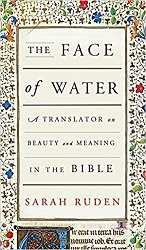
 The Face of Water
The Face of WaterA Translator on Beauty and Meaning in the Bible
Reviewed February 3, 2018.
Pantheon Books, 2017. 229 pages.
Starred Review
2018 Sonderbooks Standout:
#5 Christian Nonfiction
The Face of Water looks at the Bible as ancient literature – beautiful ancient literature. The author has translated other works of Hebrew and Greek. Now she comes at the Bible text, not as a theologian, but as a translator and as someone who has worked with these ancient languages in other contexts.
What the author is trying to do here is fairly simple:
I would read in the original languages some of the best-known passages of the Bible and describe what I saw and heard there.
So here I am now, trying to make the book less a thing of paper and glue and ink and petrochemicals, and more a living thing.
The Introduction talks about how beautiful the Bible is as literature in its original languages.
The Bible’s beauty helps explain the astonishing amount of influence this set of texts gained in itself, in defiance of hard and even disastrous circumstances. It had to be something people were genuinely attached to – not distasteful or stern or dull writing they resignedly learned and obeyed; and not decrees they regarded as trivially or oppressively superstitious but went along with for pragmatic reasons. It had to be their book; it had to win their assent by every means available.
Then she gives history of how the Bible came together. She concedes the need for translators, but then says this:
Still, to me as a reader of ancient literature, most of what I see in English Bibles is loss: the loss of sound, the loss of literary imagery, the loss of emotion, and – inevitably, because these texts were performances deeply integrated into the lives of the authors and early readers and listeners – the loss of thought and experience. A deep irony is that reverence – fear of God, deference to the religious community, reluctance to impose personal judgment on a sacred text – has the effect, over time, of flattening out the inspiring expressiveness of the original; not only the physical beauty but the actual meanings, as – I have to insist – the two aren’t separate.
In the book that follows, I will use description, analogy, speculation, and experiment in attempts to convey something of what’s lost. I may provoke a great deal of disagreement, but that’s fine. If I merely bring a fuller and more nuanced discussion of the Bible into the public sphere, where it belongs, I will have made a bigger contribution than, a few years ago, I imagined possible.
The main part of the book has an odd format. In Part One, she takes seven Old Testament passages and seven New Testament passages, one of each in each chapter, and talks about the challenges of translating those passages, talks about what special cases come up in those passages.
In Part Two, she offers (in most cases) her own translation of the fourteen passages she considered in Part One. In Part Three, she gives a more direct transliteration of the original languages for the same passages – and a literal translation in parallel.
I would have liked to have the three parts interwoven, so that after reading about John 1 in Part One, then I’d see her translation and the transliteration right away. After all, I read the book slowly, only reading a section per day, so I’d almost forgotten what was said in the first chapter of Part One before I got to Part Two. (I’m tempted to read the whole thing again and do it that way with skipping around. Perhaps someday, I will. It’s worth looking at again.)
However, despite that quibble, this book is lovely. She does manage to convey what was found in the original language in terms of sound, literary imagery, emotion, thought and expression. Her words gave me a whole new level of insight into these passages, and a different way of thinking about them.
I have to say that she chose interesting passages: The story of David and Bathsheba paired with the Lord’s Prayer; The beginning of Genesis paired with the beginning of the gospel of John; Ezekiel’s dry bones paired with martyrs before the throne in Revelation; Ecclesiastes paired with Paul’s song of God’s great love in Romans 8; the Ten Commandments paired with the parable of the Good Samaritan; and finally a chapter on “comedy”: Jonah’s preaching to the Ninevites paired with Paul’s talk in Galatians about what those who demanded Christians be circumcised could do to themselves.
I highly recommend this book to anyone who’s studied Greek or Hebrew. But I have studied neither of those, so I also recommend it to anyone who loves the Bible – you’ll gain new appreciation of its beauty and look at it in a new light.
